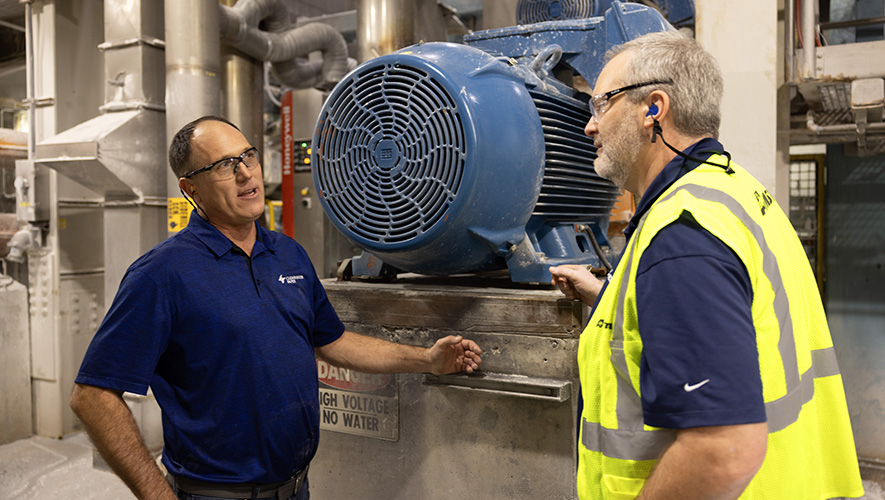Clearwater Paper in Lewiston, Idaho, a premier manufacturer of private-brand tissue and high-quality paperboard products, has been recognized by the Idaho Governor’s Office of Energy & Mineral Resources for their outstanding leadership in energy efficiency. For four consecutive years, the company has won the distinguished “Leadership in Energy Efficiency” award in the category of “Industry,” including the governor’s top honor one year.
Much of this achievement can be attributed to the efforts of Clearwater Paper’s engineering team and their long-term partnership with Avista.
According to Avista Account Executive Kim Casey, “We support Clearwater Paper with energy-efficiency expertise and incentives. Our goal is to help any business we serve to reduce their energy consumption, which reduces their operating costs and helps them be more successful.”
It’s no surprise that energy costs are one of Clearwater Paper’s largest expenses, and why the Lewiston paper plant made the decision eight years ago to begin prioritizing energy-efficient practices, according to Paper Process Control Engineer Todd Mooers.
“It began by simply asking ourselves, ‘What can we do to save energy?’” recalls Todd.
Clearwater Paper initially decided to tackle “low-hanging fruit” by upgrading some of their lighting. It wasn’t long before the energy savings from these smaller projects started adding up. It was then they reached out to Avista and learned how easy it was to receive direct money-back rebates on qualified projects.
“Avista’s program was simple and offered a good payback,” Todd explains. “The rebates combined with energy savings actually helped us afford the next project. In fact, reinvesting the money we saved enabled us to complete our first five energy-efficiency improvement projects with Avista.”
As Clearwater Paper and Avista continued exploring ways to improve energy efficiency at the plant, some of the projects would eventually require substantial investments. However, the company wisely remained committed to making small, incremental improvements, as well. The many changes led to impressive results.
In the past eight years alone, Clearwater Paper has conserved 25.5 million kWh of electricity (enough to power 2,500 homes for a year—about the total number of homes in nearby Clarkston, Washington). In that same time, Avista’s energy-efficiency incentives played a critical role in reducing project costs to ensure financial viability, ultimately helping them come to fruition.
“We drastically lowered our maintenance and labor costs, too,” Todd adds. “Back when I managed the electric shop, my rebuild budget was staggering. Today, we don’t spend a third of what we used to.”
Kim pointed out that while Avista helps most of its customers determine what energy-saving projects best fit their needs, Todd is very proactive. He has a clear understanding of his requirements and will bring Avista any idea for review.
“He never has to pay an engineering firm to do an evaluation,” she says. “Our experts at Avista are always eager to assist.”
With a chuckle, Todd adds: “Their engineer spends so much time on site, I think he was just voted ‘Employee of the Month.’”
Among many projects undertaken in the last few years were a series of 12 lighting upgrades, which involved replacing incandescent and fluorescent lights with LED fixtures throughout the plant. (This not only saved energy, but it also significantly improved safety, especially in their basement level.)
In addition, Clearwater Paper retrofitted several pump motors with VFD drives to facilitate changes in motor speeds. They reduced torque on their wood-chip-refiner motor by installing smaller, more efficient refiner plates. Plus, they addressed oversizing on a pair of 1200-RPM DC pump motors, replacing them with 900 RPM AC motors controlled by VFDs. (The pump-motor project alone saved $101,251 in annual energy costs, resulting in a payback period of just two years after rebates.)

Todd Mooers and Levi Westra discuss how to improve electric-motor efficiency.
In yet another project, Clearwater Paper replaced its air compressors with higher-efficacy, lower-horsepower models. The change dramatically reduced maintenance costs and provided an additional 500 CFM of air, allowing the plant to use one less compressor during peak production.
Todd says Avista makes his job easier, especially when seeking project approvals from his company’s board. Every Avista analysis report includes all the crucial information to make informed decisions, including estimated downtime, potential energy savings, rebate amounts and other details.
“On top of that, Avista has outperformed its estimates on every single project,” smiled Todd. “You can’t ask for a better partner than that.”
Watch Todd share more about Clearwater’s projects on Avista’s YouTube channel.